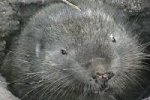 The Mountain Beaver (Aplodontia rufa) is, despite their name, actually not related to beavers. They are located in the Pacific northwest of North America and they can weigh up to 1 kilo and about 50 centimeters in length. They build extensive burrow systems with seperate chambers for storing food or droppings. They are not very social and seldom go out more than a few meters from their burrow. Their diet mainly consists of grasses and ferns and are strictly vegetarian. A range of other animals are known to live in burrow systems of the mountain beaver, among them are the Long-tailed Weasel, Ermines, Minks, Fishers, American Badgers, and Raccoons. They are hunted on by Cougars, Bobcats, Coyotes, Golden Eagles, and Owls. Because they have an effect on a lot of animals, researchers consider them to be a key species.
The Mountain Beaver (Aplodontia rufa) is, despite their name, actually not related to beavers. They are located in the Pacific northwest of North America and they can weigh up to 1 kilo and about 50 centimeters in length. They build extensive burrow systems with seperate chambers for storing food or droppings. They are not very social and seldom go out more than a few meters from their burrow. Their diet mainly consists of grasses and ferns and are strictly vegetarian. A range of other animals are known to live in burrow systems of the mountain beaver, among them are the Long-tailed Weasel, Ermines, Minks, Fishers, American Badgers, and Raccoons. They are hunted on by Cougars, Bobcats, Coyotes, Golden Eagles, and Owls. Because they have an effect on a lot of animals, researchers consider them to be a key species.
The Mountain beaver is listed as Near Threatened (LR/nt), is close to qualifying for or is likely to qualify for a threatened category in the near future, on the IUCN Red List of Threatened Species
Namings for the mountain beaver
A young / baby of a mountain beaver is called a 'kit kitten or pup'. A mountain beaver group is called a 'family or colony'.Mountain beaver habitats
Coastal Sand Dunes, Marine Coastal / Supratidal, Marine Intertidal, Sandy Shoreline and / or Beaches, Sand Bars, Spits, Etc, Shrubland and Temperate ShrublandSome facts about the
Mountain beaver
Adult weight : 1.125 kg (2.475 lbs)
Female maturity :730 days
Male maturity : 730 days
Gestation : 29 days
Weaning : 56 days
Litter size : 3
Litters per year : 1
Interval between litters : 365 days
Weight at birth : 0.026 kg (0.0572 lbs)
Weight at weaning : 0.393 kg (0.8646 lbs)
Basal metabolic rate : 2 W
Body mass : 0.707 kg (1.5554 lbs)
Temperature : 37.85 °C (100.13 °F)

Custom Search